Doge’s Palace, Venice: Essential Tips, Tours & Tickets for 2025
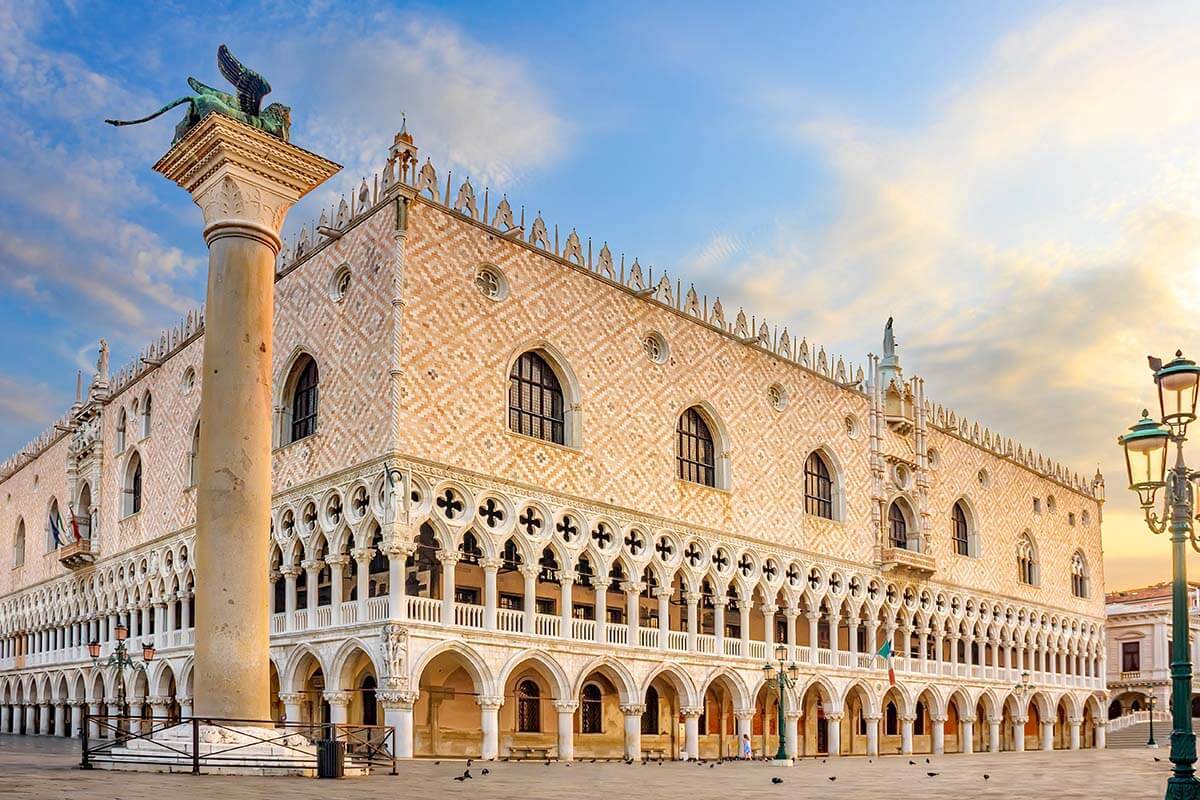
This site contains affiliate links, which means that we may earn a small commission, at no cost to you, for qualifying purchases. It supports the work that goes into keeping this content free. Thanks for reading! More info: Privacy Policy.
Thinking of visiting Doge’s Palace in Venice and wondering what to expect and if it’s worth it? In this guide, you can read all about it and learn our top tips for your first visit. Find out!
Doge’s Palace in Venice, Italy, (Palazzo Ducale di Venezia) is one of the main landmarks of the city. We have been to Venice many times and always admired the exterior of the stunning Gothic-style palace, but somehow never took the time to visit inside. We thought it was just another overhyped museum, but we couldn’t have been more wrong!
We finally visited Doge’s Palace on our recent trip to Venice and wow – the interior of the palace took our breath away! We also learned so much about the captivating history of the city that we never knew before.
If you are also wondering whether Doges Palace is worth seeing inside, what to expect, and how to make the most of your visit, this article should answer all your questions. We also include information about Doge’s Palace tickets and some of the best guided tours. Find out!
The best ticket & tour options for Doge’s Palace:
- Skip-the-line entrance ticket (a regular entry ticket).
- Secret passageways tour (includes regular entry + secret itineraries).
- Exclusive after-hours tour of Doge’s Palace & St. Mark’s Basilica (visit the two most popular attractions in Venice without the crowds).
READ ALSO: Where to Stay in Venice
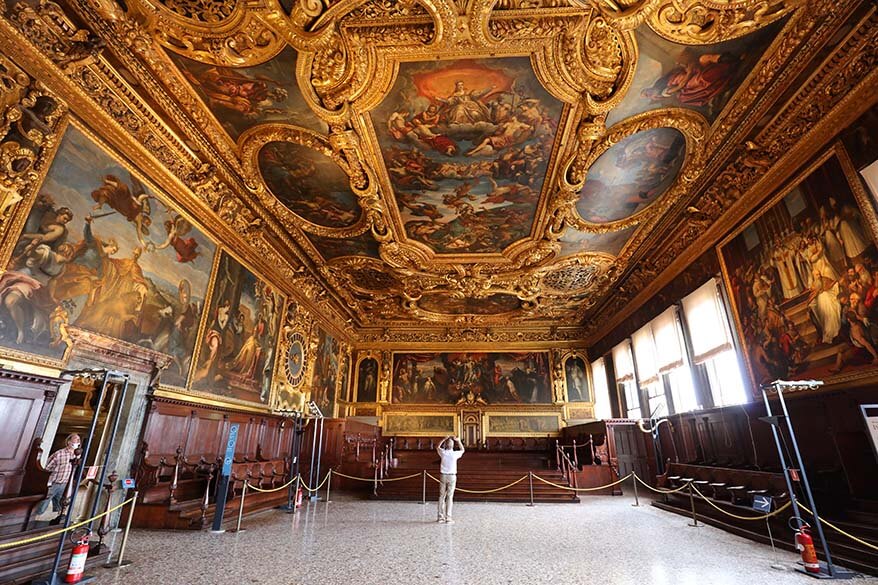
Why Visit Doge’s Palace
One of the top attractions in Venice and an integral part of the Venice waterfront, Doge’s Palace has a rich and fascinating history.
Visiting Doge’s Palace is key to understanding the city’s history. In addition, it’s well worth seeing its impressive architecture and lavish interior. It also gives you a unique opportunity to walk on the famous Bridge of Sighs.
For almost 1000 years it was the building from which 120 Doges (or chief magistrates) wielded their awesome power and decided Venice’s fate. This seat of government housed a Senate, court facilities, the secret police, and also prisons. It was also the residence of the Doge of Venice, who – once elected – would remain in his position for life.
By the end of the 13th century, Venice was one of Europe’s richest cities, mostly due to trading spices, silks, and wool between Europe and the Middle East. Its wealthy citizens became patrons of the arts, commissioning fabulous sculptures and paintings to decorate their palaces.
The building is an unmistakable testament to Venice’s wealth and power at the time! Its breathtaking facade – featuring gorgeous pink Verona marble – is a real Gothic masterpiece.

Inside you can see beautiful stone arches, magnificent sculptures, grand chambers, and historical artifacts. The museum also houses some of the most famous works of art in the world, including pieces by Titian, Veronese, and A. Vittoria.
Tintoretto’s masterpiece ‘Paradise’ – the largest oil painting in the world – hangs in the Hall of the Great Council.
Further below, you can find more information about the history of the Doge’s Palace, its most important features, and the main things not to miss on your visit. But first – some practical information and tips for your visit.
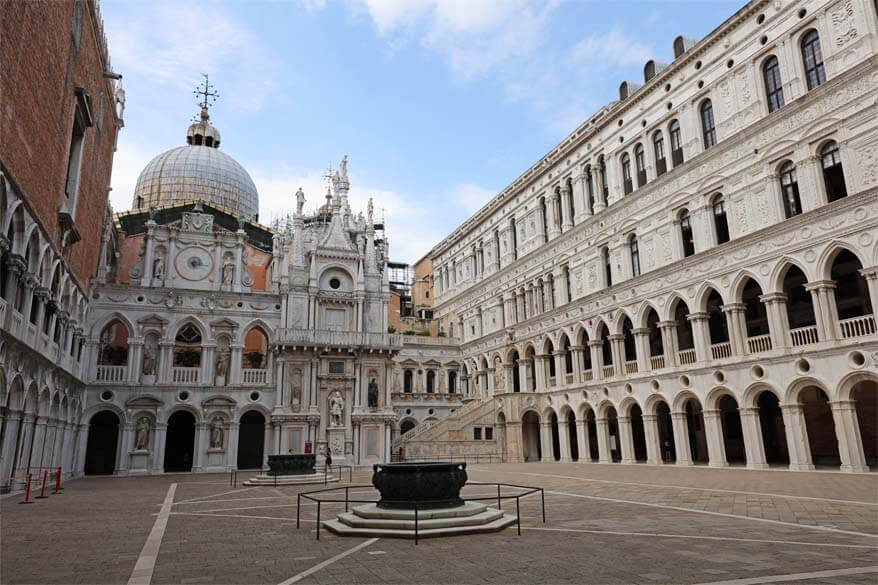
Location & Getting There
The Doge’s Palace is located on the famous St. Mark’s Square and right next to St. Mark’s Basilica. Since most of Venice’s must-see attractions are also located here, you don’t need to make any special effort to get to Doge’s Palace – it’s the main area of the city that everybody visits.
The entrance to the Palace is located on the wide waterfront promenade Riva degli Schiavoni. Nowadays, you enter the Palace through the Grain Gateway (Porta del Frumento).
You can reach Doge’s Palace on foot or by boat. If you are visiting Venice by car or by train and are walking from the Piazzale Roma area, simply follow the signs for ‘San Marco’. Count about 30-45 minutes of walking time without any stops.
A faster way to get there is by taking a public waterbus Vaporetto. Many lines stop at San Marco and you can easily get here from any part of town. Alternatively, you can also opt for a water taxi, which is by far the most luxurious, but also the most expensive way to travel around Venice.
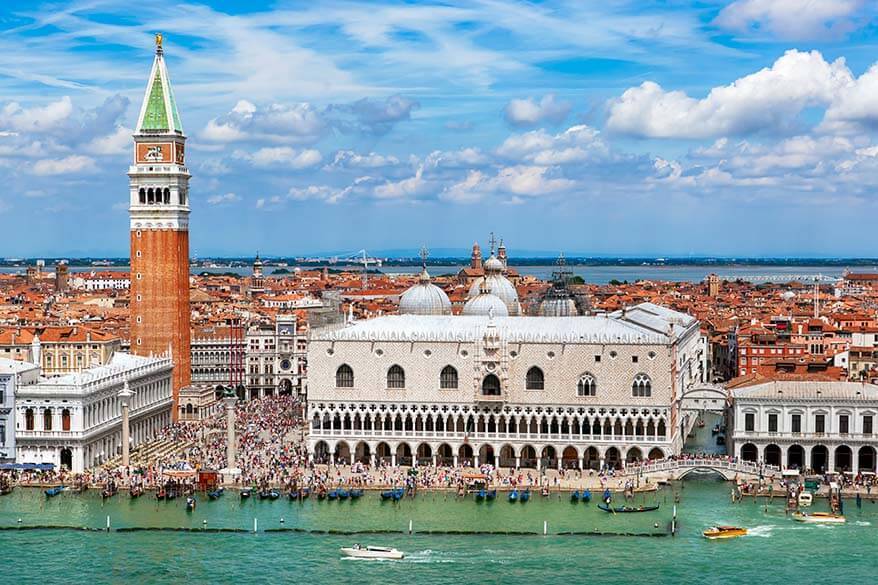
Opening Hours & Tickets
Doge’s Palace is open daily, in the high season from 9 AM to 7 PM (the last admission is an hour before the closing time). In the lower season, it closes at 5-6 PM.
At the moment of the last update, tickets to Palazzo Ducale cost around 30 EUR. There are discounts for children, students, and seniors. For up-to-date practical information, please check the website of the museum.
You can buy tickets on the official website, but we personally use GetYourGuide. The price is the same, but the booking process is incomparably simpler. Plus, on this website, you can also find the best guided tour options.
Good to know: All Doge’s Palace tickets also include the Correr Museum, National Archeological Museum, and Biblioteca Marciana (but hardly anyone visits these places).
TIP: If you are planning to visit Doge’s Palace and St. Mark’s Basilica on your own, consider this digital Venice Pass. It allows you to prebook timed entry tickets and also includes a gondola ride or the Murano & Burano islands tour. It offers very good value for the must-sees in Venice.
READ ALSO: Venice Itinerary for 3 Days
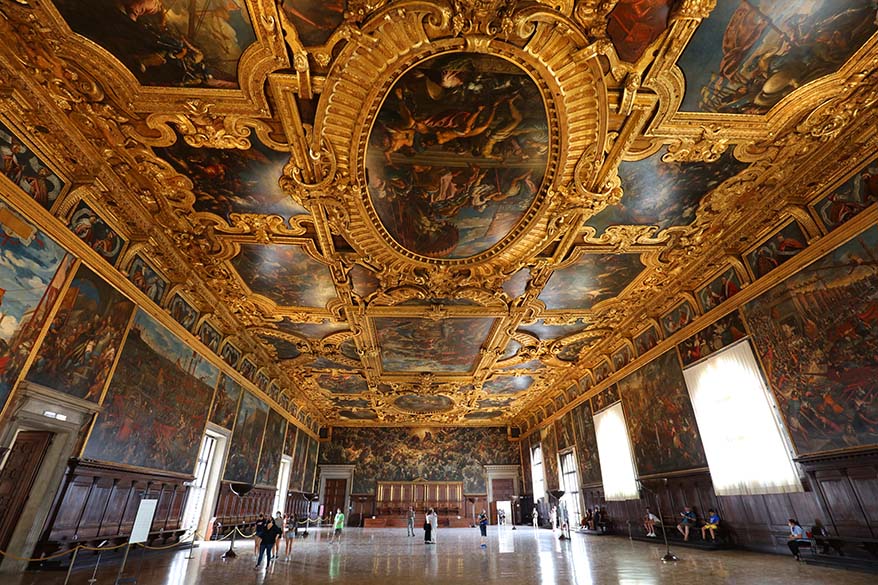
How to Visit & Tours
You can get your tickets in advance, there are informational panels inside, and so it’s very easy to visit Doge’s Palace on your own. However, it only looks simple on paper!
Together with St. Mark’s Basilica, Doge’s Palace is one of the most popular tourist attractions in the city. No matter when you come, it will always be busy here. So if you want to make the most of your visit, it’s essential to plan in advance!
If you decide to go on your own, I recommend visiting Doge’s Palace early in the morning or an hour or two before closing time. Unless you are visiting Venice in the super-low season, make sure to get skip-the-line tickets in advance. On a busy day, queues at Doge’s Palace are insane. However, there’s a separate line for those with reserved tickets. It’s absolutely worth it!
TIP: The best way to visit Doge’s Palace is by taking a guided tour. Not only do you get priority access, but going with a local guide also allows you to better appreciate everything you see. Furthermore, it’s often so busy inside that you don’t even know where to go first and you might easily skip some of the main sights without even realizing it.
So if you want to see as much as possible in a short time and also learn more about the history of Venice and the Doge’s Palace, then definitely consider going with a guide. While you can book a guided tour for the Doge’s Palace only, I recommend going on a tour that also includes St. Mark’s Basilica. It’s by far the best use of your time and money!
INSIDER TIP: If you are looking for a truly unique and unforgettable experience in Venice, check out this exclusive after-hours guided tour. It brings you to Doge’s Palace and St. Mark’s Basilica in the evening, after it closes to the general public. It’s magical!

How Much Time Do You Need
You need at least 1-1.5 hours for a quick visit to Doge’s Palace. This does not include queuing times. If you want to explore it deeper, you can spend 2-3 hours.
TIP: Going with a guided tour, you can usually visit both – Doge’s Palace and St. Mark’s Basilica – in just 2-2.5 hours. You’d never be able to see that much in such a short time on your own. If your time in Venice is limited, this is by far the best option. Check the availability and book the best-rated skip-the-line tour for these two main Venice attractions.
READ ALSO: How to See the Best of Venice in One Day
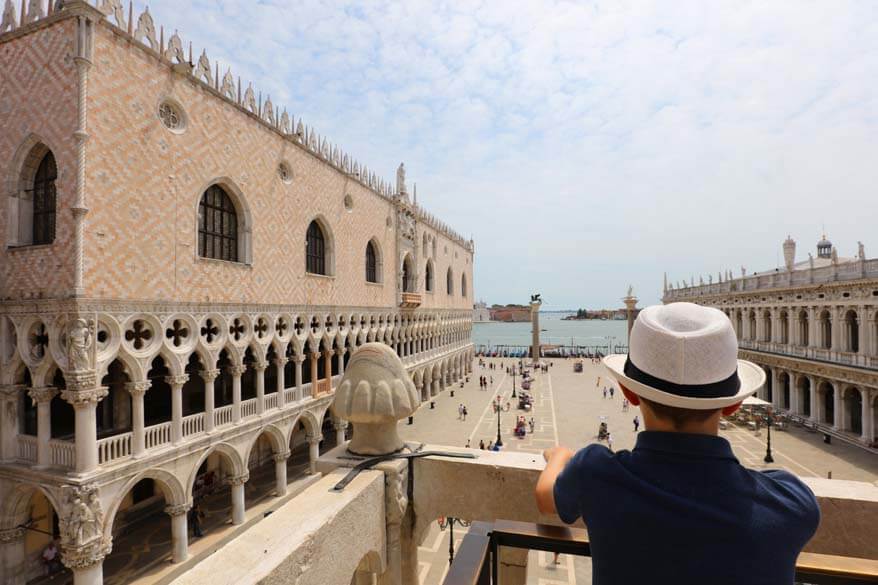
Doge’s Palace with Kids
If you are wondering whether it’s a good idea to visit Doge’s Palace with kids, I’d say go ahead. There is enough variation in what you see that even younger kids shouldn’t get bored.
Our boys were truly impressed by the sheer size of the Palace, the huge painted halls, and the armory exhibits. They also enjoyed visiting the prison cells and walking over the Bridge of Sighs. If you tell your kids some history of the place and give some explanation of what you see, they’ll enjoy the visit more.
That being said, all three of our kids (age 9-12) were quite tired after a visit here. So younger children will probably find a visit here quite tiring as well. There are lots of stairs and walking slowly can be more tiring than hours of hiking outdoors. So if you are visiting Venice with a baby or a toddler, Doge’s Palace might not be the best place to take them.
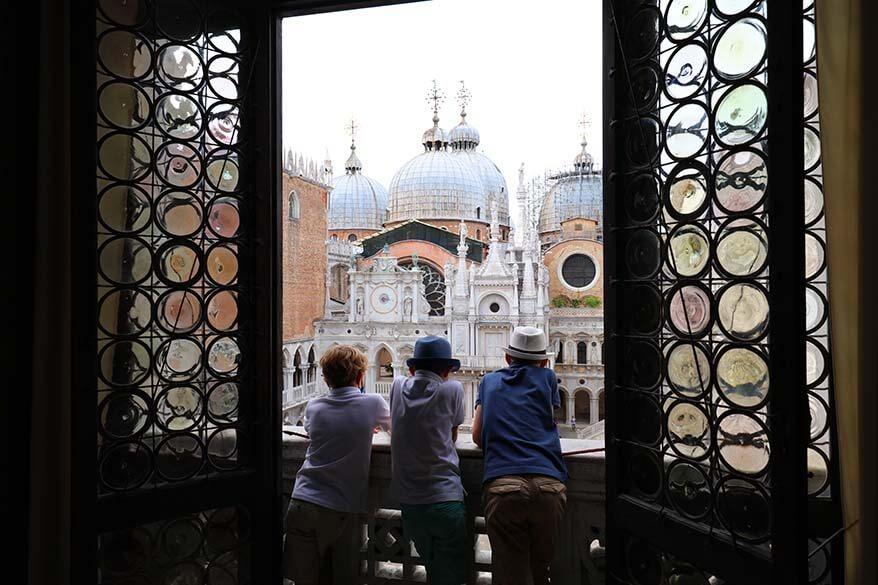
Is Doge’s Palace Worth It?
Yes, Doge’s Palace is absolutely worth a visit, even if you only have a day in Venice. Not only is it the best place to learn more about the fascinating history of Venice, but its splendid interiors will take your breath away. It’s also your chance to walk on the iconic Bridge of Sighs!
Knowing that very few citizens of Venice were ever allowed to enter this building, a visit here feels even more special.
What left the biggest impression on us was the contrast between the opulence of the luxurious residential apartments and lavish council chambers and the grim desperate conditions of its prisons. It’s an eye-opening experience that will help you to better appreciate what a fascinating city Venice really is.
Below, you can read more about the history of Doge’s Palace and find a short list of the main points of interest to see inside. Take a look!
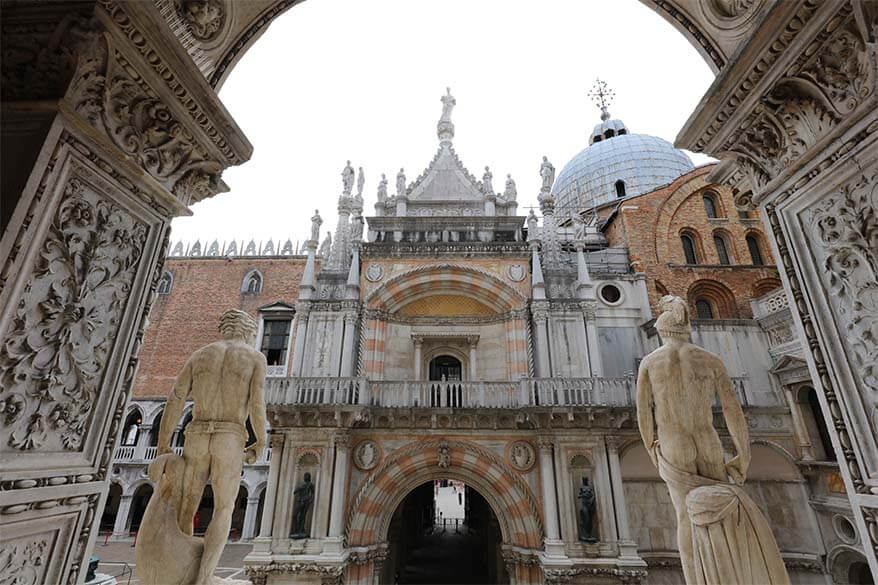
History
The Doge’s Palace – with its strategic location at the point of access to the sea – was built around the 9th century as a fort. Originally with a tower at each corner, the building has seen many changes over the years. This is reflected in the mixture of architectural styles from several periods.
In the 12th century, Doge Sebastiano Ziani transformed the fort into a palace. It was gradually expanded throughout the 13th and 14th centuries.
Unfortunately, a number of destructive fires did enormous damage to the building in the 16th century. However, because of this, the palace was restructured and improved. Some of its most beautiful additions, such as the Stairs of the Giants, were made at that time.
The original building already housed prisons – known as ‘Piombi‘. In the 17th century, new prisons were built to supplement them. The Bridge of Sighs connecting the new prisons to the palace across the canal also dates from this time.
In the 18th century, the Palace was slightly remodeled to house administrative offices and it was still used as a prison. After 1866, when Venice was annexed to Italy, Doge’s Palace was restructured several times. It finally became a museum in 1923.

Things to See Inside
There is so much to see inside the Doges Palace! If you follow the indicated route, you’ll pass all the main sights. However, it can get so overwhelming that it’s easy not to notice some of the nicest features. So here are the main points of interest that you shouldn’t miss when visiting Doge’s Palace:
Courtyard & Staircase of the Giants
The impressive courtyard is the first place you see when you enter the Palace. The highlight of the courtyard has to be the Staircase of the Giants (Scala dei Giganti), at the top of which the doge’s coronation would take place.
In the 15th century, the Great Council came up with an idea for creating a ceremonial staircase. The Giants Staircase takes its name from the two enormous statues of Mars and Neptune that symbolize Venice’s power by both land and sea.
To the right of the Giant’s Staircase is the Senator’s Courtyard. This is where the members of the senate would gather before government meetings. In the middle of the courtyard, you can see two well-heads dating from the middle of the 16th century.
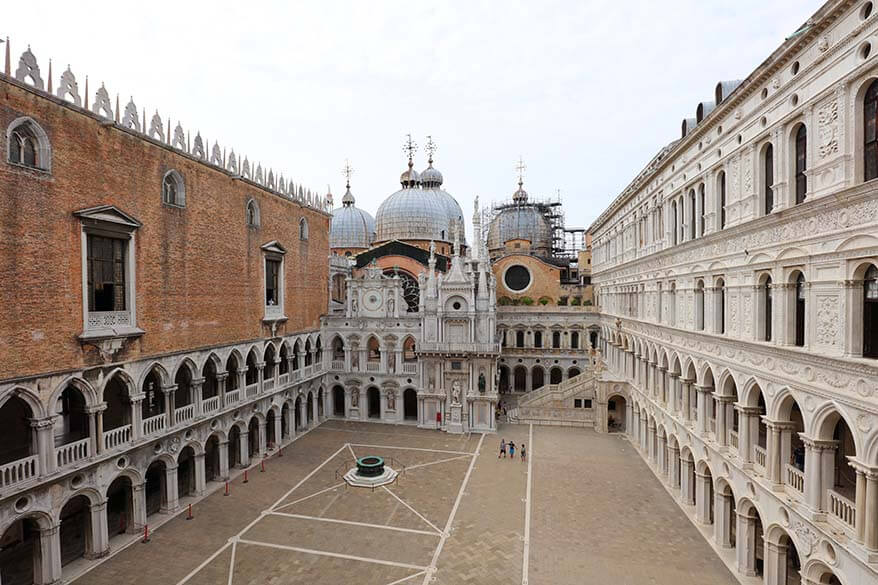
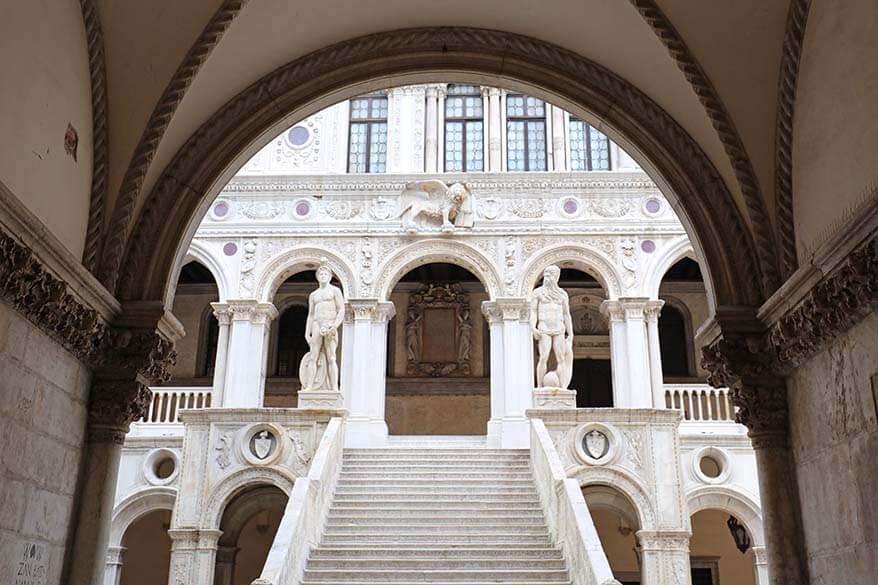
Golden Staircase
Golden Staircase (La Scala d’Oro) is a very impressive ceremonial staircase leading up to Doge’s apartments and to the chambers of the state government.
The staircase was completed in 1559 and is indeed decorated with real 24-carat gold.
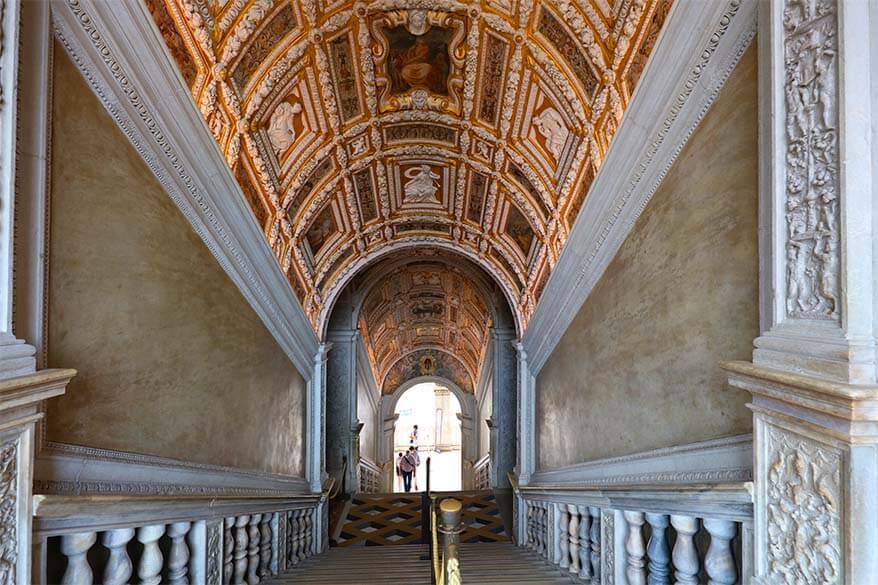
Doges’ Apartments
The Doges’ Apartments on the second floor are very impressive but quite modest in size (especially when you consider the power of the various doges that occupied them). This was probably a deliberate reminder that although the doge was a state symbol, he was – more importantly – its first servant.
The original rooms were destroyed by fire in 1483 and the apartments were rebuilt in Renaissance style. They were individually furnished by each incoming doge, using items from his previous home. On his death, his furnishings would be removed to make way for his successor.
Today they still house some incredible artwork, including the 16th-century fireplace and the carved ceiling of the Sala degli Scarlatti.
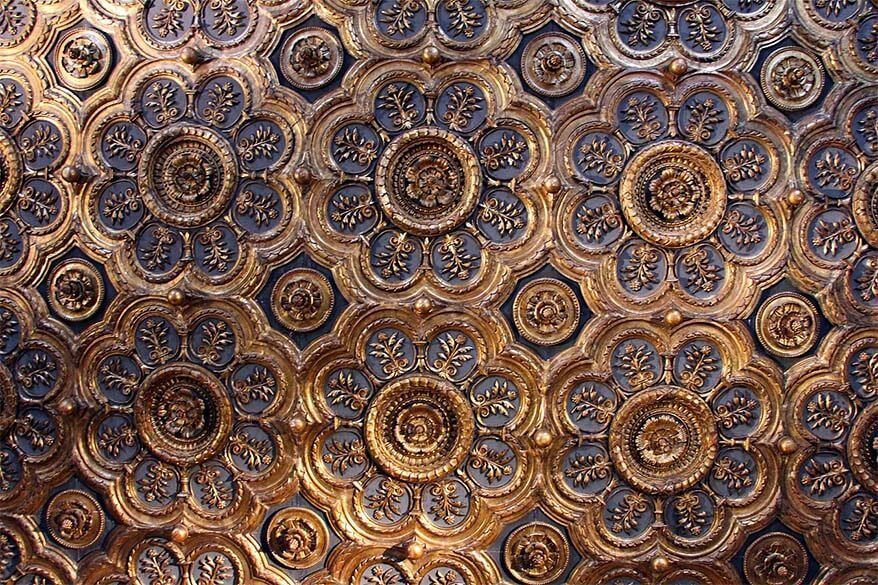
Senate Hall
Senate Hall (Sala del Senato) is an imposing and lavishly decorated Hall. It was used for various governmental functions, including the appointment of new ambassadors and the making of important decisions on foreign policy.
Venice’s Senate was founded in the 13th century and was one of the city’s oldest public institutions. It was made up of members chosen from the city’s wealthiest families. Its areas of responsibility included financial and political affairs, trade, and manufacturing.
In 1574, a fire damaged much of the Hall and it was refurbished in the 1580s. Its ceiling was beautifully decorated with Tintoretto’s ‘Triumph of Venice‘, whilst the main focus of the Hall became another of Tintoretto’s works, ‘Christ‘.
This painting was likely commissioned in acknowledgment of the Senate’s ‘conclave’. Responsible for electing the doge, the conclave was seen as being protected by the Son of God. Under the painting, you will see the ornamental seat in which the doge would sit during meetings.
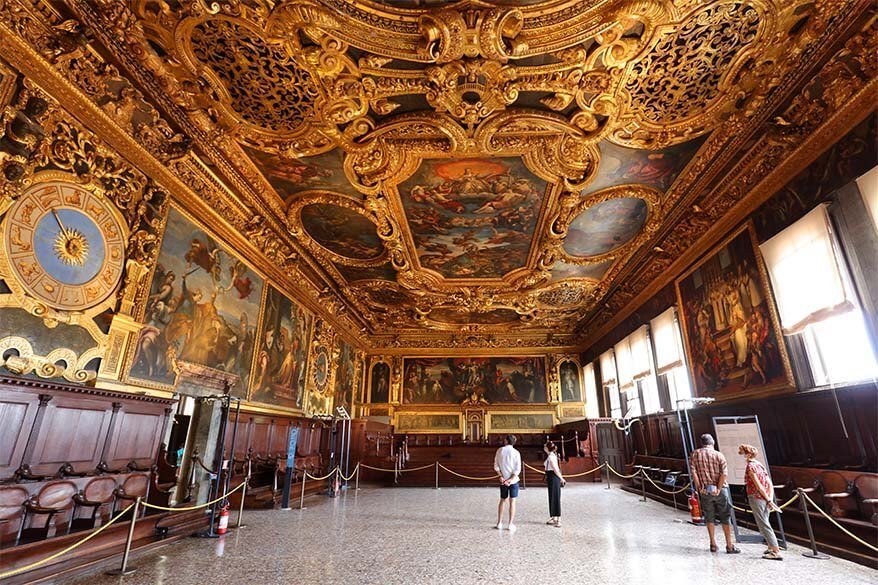
Chamber of the Great Council
The Great Council Hall (Sala del Maggior Consiglio) is an even bigger hall with stunning paintings on all walls and ceilings. The Great Council, the most important political body in the Republic of Venice, held its meetings here.
This room is huge and measures 53 meters in length and 25 meters in width. It was one of the largest halls in Europe and could fit up to 2000 people. It was clearly built and decorated to show power and wealth and to impress whoever visited here. Its lavish decorations and beautiful paintings reminded me of the Painted Hall in London.
There are 35 painted panels on the ceiling. The most famous of them all is the Apotheosis of Venice, a painting by Paolo Veronese, dating from 1585. Just under the ceiling, you can see portraits of the first 76 doges of Venice. The portraits of the later doges can be found in the Sala dello Scrutinio.
Tintoretto’s painting ‘Il Paradiso’ – the world’s largest oil painting on canvas – can also be found in this room.
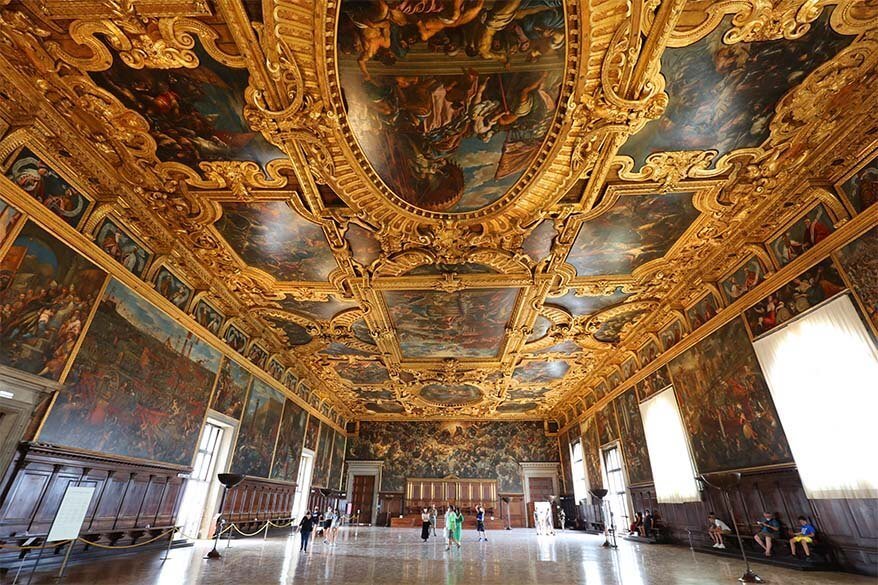
Bridge of Sighs
One of the most famous bridges in the world, the Bridge of Sighs (Ponte dei Sospiri) was designed by Antonio Contino. It was built in 1600 in order to connect the interrogation rooms and courts of the Palace to the new prisons on the other side of the canal. This is the route that convicted prisoners would have taken to their cells after sentencing.
Lord Byron mentioned the bridge in 1812 in his book ‘Childe Harold’s Pilgrimage’, saying “I stood in Venice, on the Bridge of Sighs; A palace and a prison on each hand.” It is this reference that likely led to the bridge’s fame.
The Bridge of Sighs got its name in around the 18th century. It refers to the sighs of the prisoners who took a last glimpse of the outside world through the tiny openings of this enclosed bridge on their way to the prison cells.
In reality, looking across Venice from this enclosed bridge is actually quite difficult. There are just a few small openings from which you can get a glimpse of the hustle and bustle of the canal below.
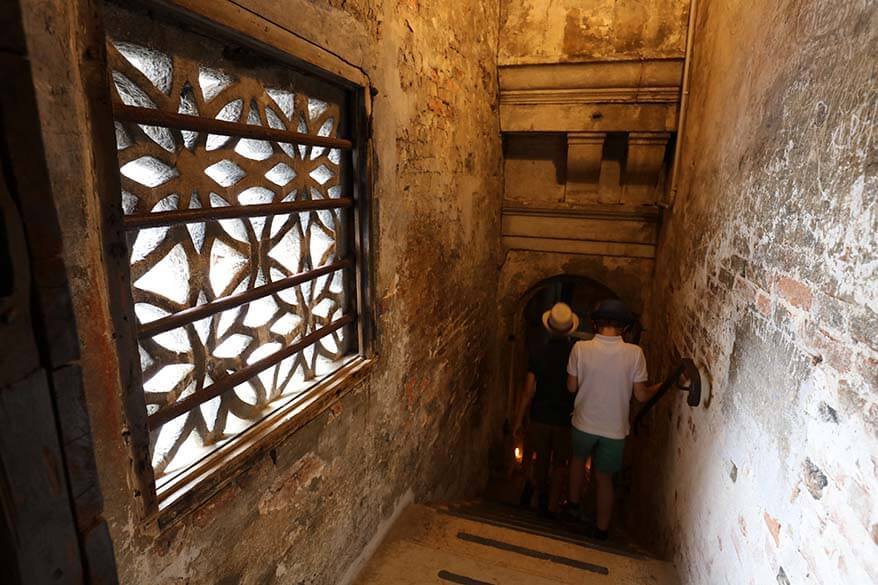
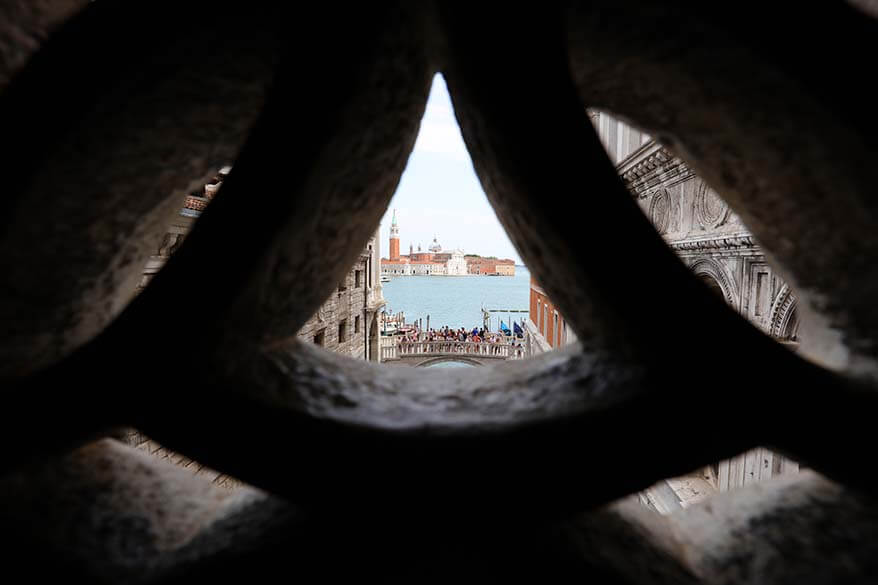
Interesting to know: The interior of the enclosed bridge is divided into two separate corridors. That way, prisoners walking in one direction wouldn’t meet anyone coming from the other side. When you are visiting Doges Palace, you’ll walk over the bridge twice without even realizing that there is another side of it.
Despite its grim history, the bridge – made of white limestone – is quite beautiful. Happily, it has now become a symbol of romance. According to a popular legend, couples sailing beneath it on a gondola – kissing as they pass – will experience eternal love.
TIP: You can also see the Bridge of Sighs from the bridge at Riva degli Schiavoni and also from the other side. And indeed, if you take a gondola ride in St. Mark’s area, you can pass under the bridge in a gondola.
READ ALSO: Tips for a Gondola Ride in Venice

Prison Cells
The cold dark prison cells form a sharp contrast with the luxurious chambers of the Doge’s Palace. It’s almost hard to believe that this is the same building!
Dating back to the 12th century, the prison cells of Doge’s Palace are composed of the Piombi, the Pozzi, and the Prigioni Nuove (New Prisons). Conditions in the prisons were truly terrible, and few of those who entered them would ever see the light of day again.
It was very easy to end up in prison in Venice at that time! The Palace was surrounded by mailboxes shaped like lions’ mouths, into which citizens could post pieces of paper bearing the names of neighbors they suspected of wrongdoing. All accusations were thoroughly investigated and tried by the dreaded Council of Ten, one of the main governing bodies throughout the 14th – 18th centuries. Those who were convicted were sent to the cells within the Palace walls.
In English, the Piombi is known as the ‘Leads’, because the cells were located directly under the lead-covered roof. This made them unbearably hot in summer and bitterly cold in winter. As bad as they were, they were still better than the ‘Pozzi’ on the ground floor. These cells were damp, tiny, and barely lit, with just a bucket for excrement. The conditions in the New Prisons were somewhat better, though still incredibly harsh.
Though notoriously difficult to escape, one famous prisoner managed to do so – see below!
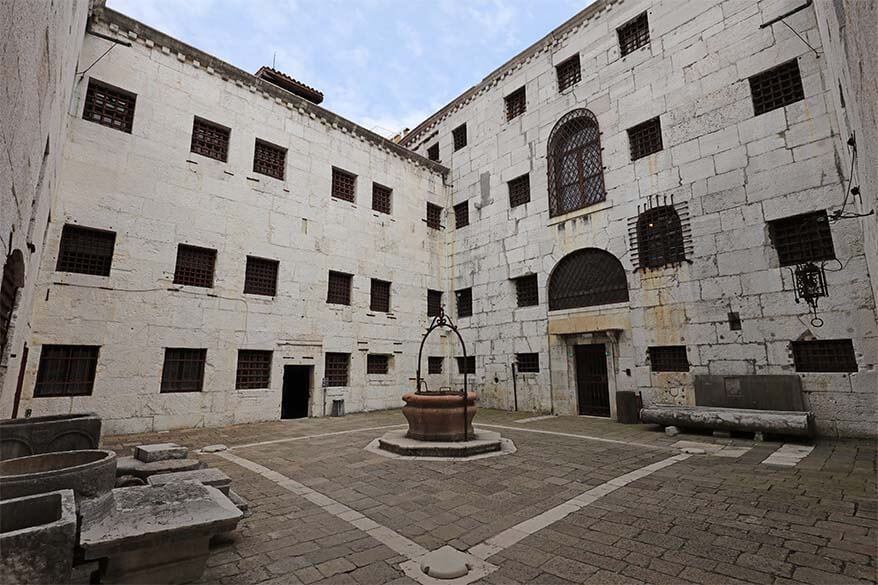

Secret Prison Cells, Archives & Casanova’s Cell
This part of the Doge’s Palace is not included with regular tickets and can only be visited with a guided ‘Secret Itineraries’ tour.
Via a series of hidden passageways and staircases, you explore the hidden side of Doge’s Palace. You will see the archives, the armor collection in the attic, torture and execution rooms, and several secret prison cells. You will also visit several stunning chambers that aren’t accessible to the general public.
On this tour, you will also hear about Casanova, the most famous prisoner ever held in Doge’s Palace, and learn about his incredible escape story from 1756. This tour also takes you to the prison cells where Casanova was held.
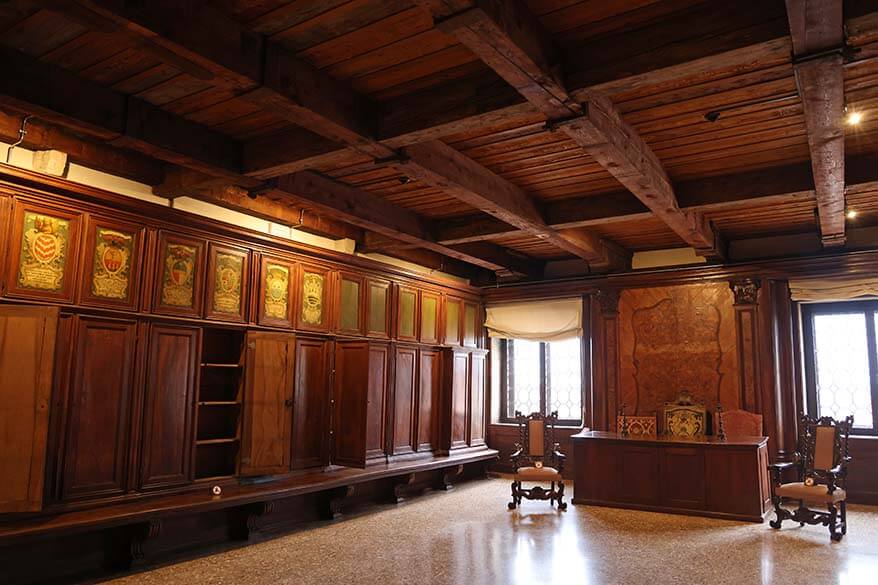
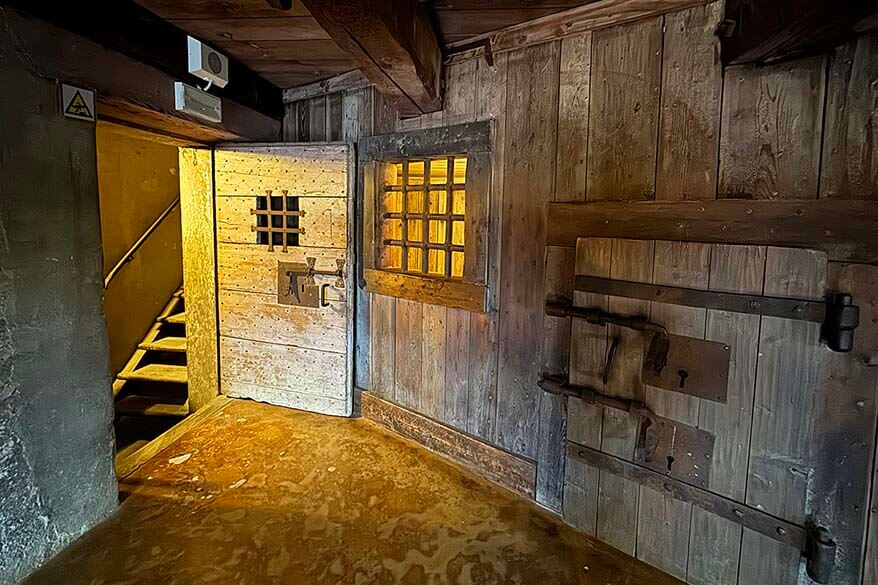
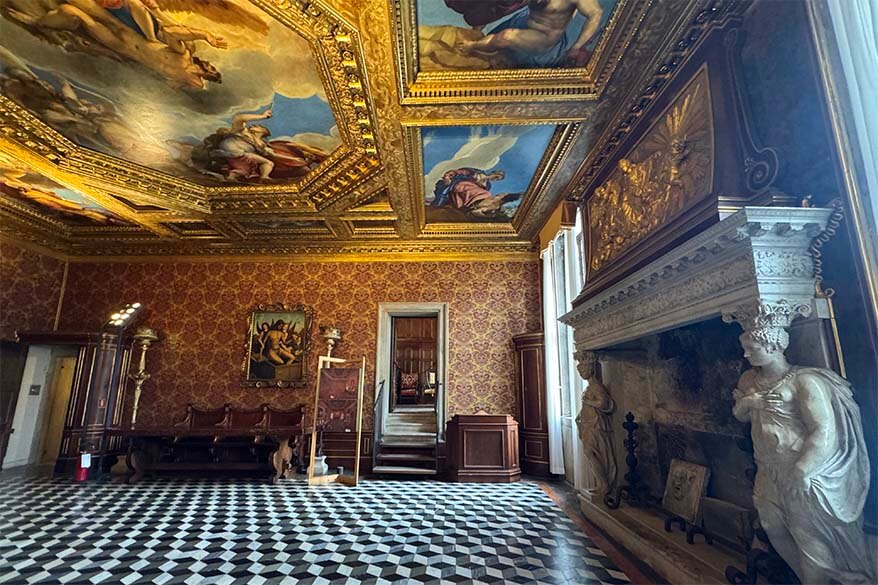
Paper Gate
The Paper Gate (Porta della Carta) was originally the main entrance to the Palace and links the Palace to St Mark’s Basilica. Nowadays, you leave the Palace via this gate. It’s most impressive when viewed from St. Mark’s Palace, so make sure to look back as you are leaving!
TIP: Even if you are not visiting inside the Doge’s Palace, you can still see this gate. You can find it on the right side of St. Mark’s Basilica; where it connects to the Doge’s Palace.
The origin of its name is not clear. Some say it is the ‘Paper Gate’ because it is near the area in which the scribes would put up their desks, or where people waited to hand their petitions to council members. Others believe that its name came from the ‘cartabum’ – the archive of state documents that is located nearby.
Considered to be one of the finest examples of Venetian Gothic architecture, the 15th-century Paper Gate features ornate carved figures. Its most remarkable feature is the sculpture of Doge Francesco Foscari kneeling in front of the lion of Saint Mark. This sculpture is actually a 19th-century copy of the original, which was destroyed in 1797 when Venice was invaded by Napoleon’s army. The sculpture is said to be symbolic of the fact that even the mighty doge must bow before the power of the state.

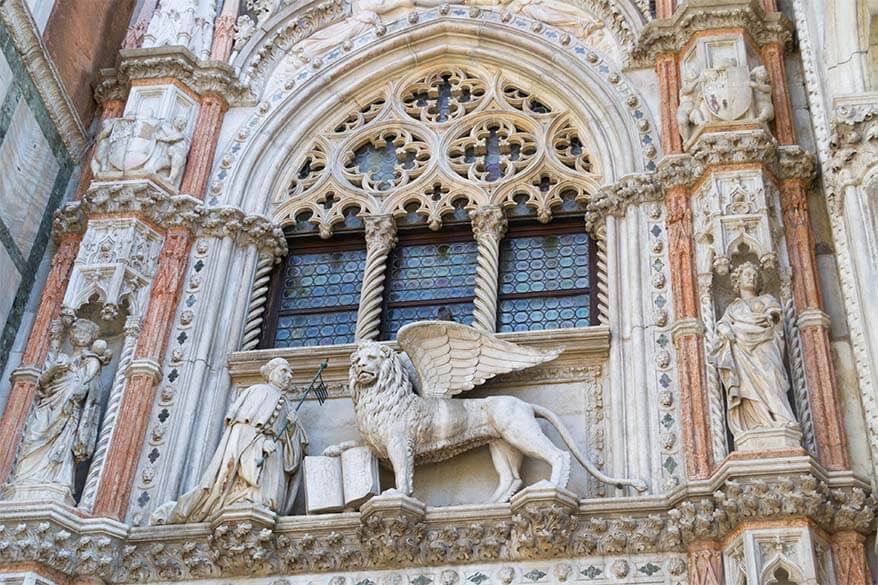
So, this is our guide to visiting the famous Doge’s Palace in Venice. If you plan well and get your tickets (or book a tour) in advance, a visit here only takes an hour or two of your time. So don’t miss it! This is truly one of the must-see places in Venice.
TIP: If you are wondering how to plan your time in Venice, take a look at our suggested itineraries:
- 1 Day in Venice
- 3 Days in Venice (it will also work for 2 days – just pick the sights that interest you the most).
READ ALSO: What to See & Do in Venice (all the top sights and attractions that you shouldn’t miss)
Travel inspiration for Italy:
- Best Places to See in Italy
- Italy Itinerary for First Visit
- Best Towns in Tuscany
- Tips for Cinque Terre
- Tips for Amalfi Coast
- Best Italian Cities to Visit
- Best Places in the Dolomites
- Best Hikes in the Dolomites
- For many more destinations see our Italy travel guide.
TIP: Did you find this guide helpful? Bookmark this post for later, share it with your friends, and save it to Pinterest to inspire your next trip.

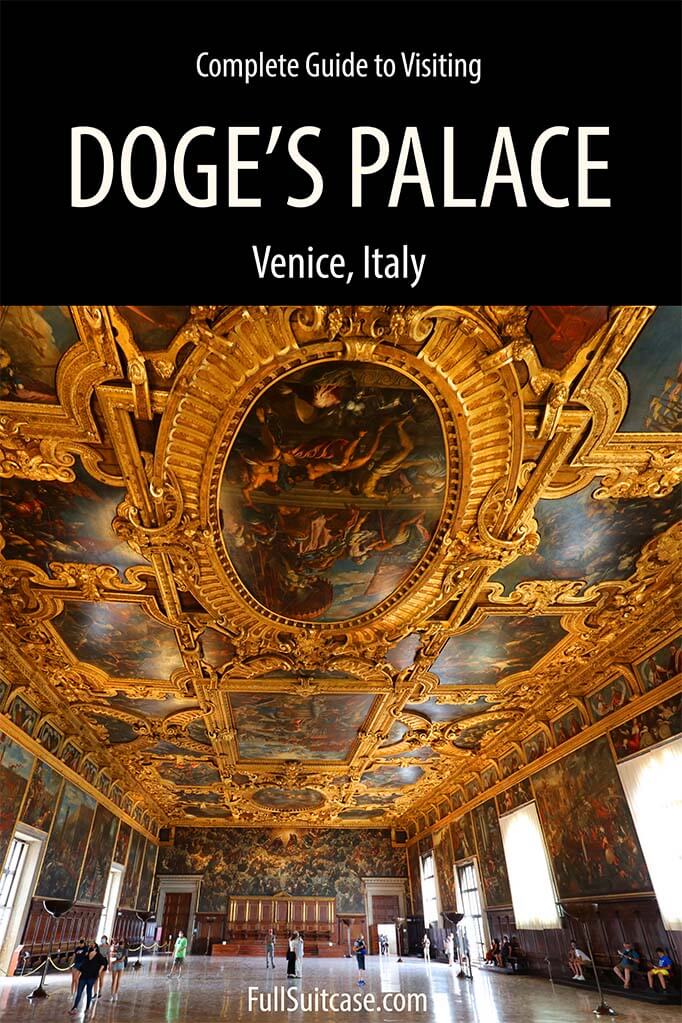







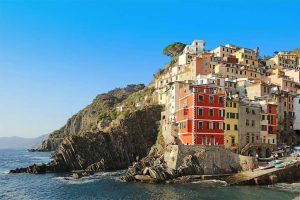
Thank you! One of the best written visits for Doge Palace!
Thanks for your kind feedback. Enjoy Venice!
Thank you for this! All your information was very helpful!! I was trying to book tickets on their website & found it very confusing as you mentioned too! I wasn’t quite sure what I was buying even though I had selected “ English”. I used one of the links you listed to grab the tickets ahead with it being the same price! Love, love all the info about Doge’s Palace that you wrote! Very helpful & relevant ( even the fact that Doges palace means Palazzo Ducale!)
Thank you for your kind feedback, Sabrina. Appreciate it.
And yes, it’s often so much easier to get tickets via Tiqets or GetYourGuide than direct. We get all our tickets/tours via these companies nowadays and it makes any trip planning much simpler.
Enjoy your trip!
Is it possible to visit the courtyard without purchasing tickets to go inside the apartments and museums?
Hi Tanya, the entrance and the security check are located before you enter the courtyard, so no, you cannot see it without a ticket.